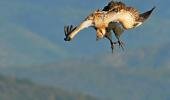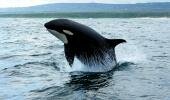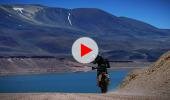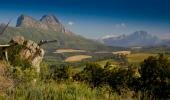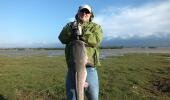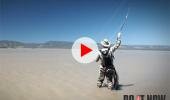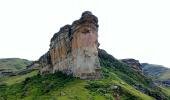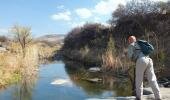Words & Photos: Lloyd Edwards
I saw my first group of killer whales near Bird Island in Algoa Bay on 20 February 1999. It was a group of four (three adults and a calf) that had captured a baby bottlenose dolphin and were flicking it to each other using their large flippers. The cries of the baby dolphin were quite unnerving, but in this case, the whales were honing their skills, just like when a cat plays with a mouse, and is one of the cruel things in nature that is necessary for this top predator’s survival.

Photo credit: Lloyd Edwards
Since then I have spotted them on numerous occasions from my whale watching boat and the shore, but I had never been treated to such a show as on 13 January, where they followed our boat for more than three hours, delighting us with numerous forms of behaviour and making their message very clear.
The male killer whale was spy hopping, whereby it changes the shape of the lens in the eye to give them excellent vision both in and out of the water. This is used to great effect when knocking seals off ice floes. The whales would suddenly pop out the water next to the boat and have a good look at us and what we were doing. The male was also tail slapping, which may be a form of aggression to warn intruders to keep away from its calf, but scientists don’t know for sure what it means. The female was breaching regularly and this could be some form of communication to the other members of the pod, or may be simply for fun.
My fascination with these amazing creatures continues to grow and I have spent many an hour delving into their behaviour, the different types of killer whales and how to recognise them, and the many other nuances that make them the top predator in the marine ecosystem. Here are just a few interesting facts about killer whales.
Photo credit: Lloyd Edwards
Did you know?
• Killer whales, also known as orca whales, are the largest member of the dolphin family. When any cetacean (group name for whales, dolphins and porpoises) attains more than four metres, it is classified as a whale (with the exception of the dwarf and pygmy sperm whales).
• The name orca is derived from Orcus, the Roman god of the underworld who tortured wrongdoers in the afterlife. The term ‘killer whale’ probably comes from the fact that they kill other whales and were often seen feeding on dead whales during the days of whaling.
• There are at least nine main types of killer whales in the world; two in the North Atlantic, three in the North Pacific, and four in the Southern Hemisphere. In the Southern Ocean, recent observations have revealed the possible existence of four more types of killer whales. One of the main differences between them is their diet.
• Scientists use the notches and unique markings on the dorsal fins and grey saddles (just behind the dorsal fin) to identify individual animals.
• They are the top predators in the marine ecosystem and their diet consists of almost everything in the sea, as well as some animals out of it. Animals eaten or harassed include 20 species of cetaceans, 14 species of seals and their kin, dugongs, sea otters, 11 species of bony fish, 12 species of elasmobranch fish (sharks and rays), birds, turtles, squid, and even deer and moose!
• When attacking southern right whales, killer whales will try to split up the group or cow and calf pair. Once killed, the killer whales usually only eat the tongues, which seem like a delicacy to them.
• Passive sonar is a hunting method used to hear sounds made by other cetaceans. Once located they then use ambush tactics, communicating with each other once a kill is made.
• Killer whales are often confused with humpback whales, as the underside of their tail flukes is sometimes also black and white, like those of killer whales. Similarly, when a southern right whale lies on its side, its tail often resembles the dorsal fin of a killer whale.
• Females can live to a maximum of 90 years, while males seldom reach more than 60 years of age.
• Males have larger flippers and tail flukes than females.
• Males can weigh up to five-and-a-half tons, while females are smaller.
• The largest males are almost nine-metres long, while the females reach almost eight metres. Most females seldom reach seven metres, while 50% of males do.
• Killer whales are the world’s most widely distributed mammal, but appear to be more abundant in cooler waters. They can be seen anywhere along the southern African coast, however they tend to frequent places of heavy boat traffic, like the Cape Peninsula, Plettenberg Bay, and Algoa Bay in the old whaling grounds. Their appearances are unpredictable in and around Algoa Bay and normally not more than twice a year. Some years they fail to arrive at all. The last time they were spotted in the Eastern Cape was in May 2011, at the tail end of the sardine run off Cape Recife.
It is a huge privilege to observe these wonderful animals along our coastline and to date there have been 785-recorded sightings of killer whales along the South African coastline. Although this may seem a lot, their numbers are on the decline. We can only hope that with the cessation of whaling, they will increase in numbers and be observed more frequently.
More information:
If anyone should spot a killer whale in the vicinity of Port Elizabeth, they are to please contact Lloyd Edwards of Raggy Charters via email on . Once a positive identification is made, you are welcome to join Raggy Charters on its whale watching boat, at no cost, to get close-up footage, which will also be passed onto the relevant marine whale scientists.
Lloyd’s full article on killer whales will make up one the chapters in his new book on the marine life of Algoa Bay.
Anyone wishing to purchase A2 size photographs of killer whales, like those in this article, can email Lloyd. Proceeds will go to the Penguin Research fund.
Sources:
Most of the above information was obtained from the following:
• Killer whales in SA waters. PB Best, MA Meyer and C Lockyer. March 2010. African Journal of Marine Science.
• Best PB. 2007. Whales and dolphins of the southern African sub region. Cape Town. Cambridge University Press.
• Cockcroft Vic, Joyce P. 1998. Whale Watch. Cape Town.
Struik Publishers.
• Edwards LC. 2005. Scenes from Algoa Bay, a photographic guide to the marine mammals of Port Elizabeth.
The Advertising Empire.
• Logbook of Commercial Whale Watching Vessels “Orca PEC 3 and Orca 2 PEC 17” December 1997 until 2012 and Penguin Research Vessel “Winkle” June 2011 until February 2012.
